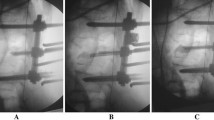Abstract
Background
Internal fixation of unstable thoracolumbar spine fractures requires correction of the lacking anterior column support. This usually entails insertion of a vertebral body replacement strut through an anterior approach, or a long posterior construct spanning at least two vertebrae above and two vertebrae below the fracture. Posterior short-segment pedicle instrumentation (SSPI)—one vertebra above and below—is suitable for approximately 40% of fractures, but not for all.
Methods
A total of 52 patients with unstable thoracolumbar burst fractures meeting our inclusion criteria were instrumented using a novel approach, combining percutaneous SSPI, pedicle screw augmentation with polymethyl methacrylate (PMMA) and fractured vertebra kyphoplasty. We retrospectively reviewed patient and fracture data, operative results and 1 year radiographic follow-up postoperatively in 40 of the patients. We reviewed operative complications of all 52 patients.
Results
Most fractures were AO/Magerl type A3.1, A3.2 and A3.3. They were instrumented within 72 h and ambulated without additional external bracing. Operative time averaged 2 h and blood loss was less than 50 cc in most cases. Complications were mostly related to PMMA leakage. On average, 3.3° (0–13) of correction was lost after 3 months, but remained constant afterward.
Conclusions
Percutaneous augmented short-segment pedicle instrumentation of unstable thoracolumbar fractures can be done with short operative times, minimal blood loss and a low complication rate. The radiographical results at 1 year are equal to anterior stabilization and are better than other posterior-only techniques.


Similar content being viewed by others
References
Mikles MR, Stchur RP, Graziano GP (2004) Posterior Instrumentation for thoracolumbar fractures. J Am Acad Orthop Surg 12:424–435
Schinkel C, Anastasiadis AP (2008) The timing of spinal stabilization in polytrauma and in patients with spinal cord injury. Curr Opin Crit Care Dec 14(6):685–689
Schinkel C, Frangen TM, Kmetic A, Andress HJ, Muhr G, German Trauma Registry (2006) Timing of thoracic spine stabilization in trauma patients: impact on clinical course and outcome. J Trauma 61(1):156–160. (Discussion 160)
McLain RF, Sparling E, Benson DR (1993) Early failure of short-segment pedicle instrumentation for thoracolumbar fractures. A preliminary report. J Bone Jt Surg Am 75(2):162–167
Parker JW, Lane JR, Karaikovic EE, Gaines RW (2000) Successful short-segment instrumentation and fusion for thoracolumbar spine fractures: a consecutive 41/2-year series. Spine 25(9):1157–1170
Afzal S, Akbar S, Dhar SA (2008) Short segment pedicle screw instrumentation and augmentation vertebroplasty in lumbar burst fractures: an experience. Eur Spine J 17(3):336–341
Pflugmacher R, Agarwal A, Kandziora F, K-Klostermann C (2009) Balloon kyphoplasty combined with posterior instrumentation for the treatment of burst fractures of the spine–1-year results. J Orthop Trauma 23(2):126–131 PubMed PMID: 19169105
Marco RA, Kushwaha VP (2009) Thoracolumbar burst fractures treated with posterior decompression and pedicle screw instrumentation supplemented with balloon-assisted vertebroplasty and calcium phosphate reconstruction. J Bone Joint Surg Am 91(1):20–28 PubMed PMID: 19122075
Korovessis P, Hadjipavlou A, Repantis T (2008) Minimal invasive short posterior instrumentation plus balloon kyphoplasty with calcium phosphate for burst and severe compression lumbar fractures. Spine 33(6):658–667
Acosta FL Jr, Aryan HE, Taylor WR, Ames CP (2005) Kyphoplasty-augmented short-segment pedicle screw fixation of traumatic lumbar burst fractures: initial clinical experience and literature review. Neurosurg Focus 18(3):e9 PubMed PMID: 15771399
Cho DY, Lee WY, Sheu PC (2003) Treatment of thoracolumbar burst fractures with polymethyl methacrylate vertebroplasty and short-segment pedicle screw fixation. Neurosurgery 53(6):1354–1360
Magerl F, Aebi M, Gertzbein S, Harms J, Nazarian S (1994) A comprehensive classification of thoracic and lumbar injuries. Eur Spine J 3:184–201
Payer M (2006) Unstable burst fractures of the thoraco-lumbar junction:treatment by posterior bisegmental correction/fixation and staged anterior corpectomy and titanium cage implantation. Acta neurochir (Wien) 148:299–306
Ragel B, Kan P, Schmidt M (2010) Blood transfusions after thoracoscopic anterior thoracolumbar vertebrectomy. Acta Neurochir 152:597–603
Venmans A, Lohle PN, van Rooij WJ, Verhaar HJ, Mali WP (2008) Frequency and outcome of pulmonary polymethylmethacrylate embolism during percutaneous vertebroplasty. AJNR 29(10):1983–1985
Kim YJ, Lee JW, Park KW, Yeom JS, Jeong HS, Park JM, Kang HS (2009) Pulmonary cement embolism after percutaneous vertebroplasty in osteoporotic vertebral compression fractures: incidence, characteristics, and risk factors. Radiology 251(1):250–259
Webb JC, Spencer RF (2007) The role of polymethylmethacrylate bone cement in modern orthopaedic surgery. J Bone Joint Surg Br 89(7):851–857
Burval DJ, McLain RF, Milks R, Inceoglu S (2007) Primary pedicle screw augmentation in osteoporotic lumbar vertebrae. Spine 32(10):1077–1083
Fuentes S, Blondel B, Metellus P, Gaudart J, Adetchessi T, Dufour H (2010) Percutaneous kyphoplasty and pedicle screw fixation for the management of thoraco-lumbar burst fractures. Eur Spine J 19(8):1281–1287
Palmisani M, Gasbarrini A, Brodano GB, De Iure F, Cappuccio M, Boriani L, Amendola L, Boriani S (2009) Minimally invasive percutaneous fixation in the treatment of thoracic and lumbar spine fractures. Eur Spine J 18(Suppl 1):71–74
Acknowledgments
Research funds have been received during the preparation of this work from the following: The Western Galilee Hospital, Israel Spine Society, Medtronic Israel, Tzamal-Jakobsohn Ltd., Israel.
Conflict of interest
None.
Author information
Authors and Affiliations
Corresponding author
Electronic supplementary material
Below is the link to the electronic supplementary material.
Rights and permissions
About this article
Cite this article
Rahamimov, N., Mulla, H., Shani, A. et al. Percutaneous augmented instrumentation of unstable thoracolumbar burst fractures. Eur Spine J 21, 850–854 (2012). https://doi.org/10.1007/s00586-011-2106-x
Received:
Revised:
Accepted:
Published:
Issue Date:
DOI: https://doi.org/10.1007/s00586-011-2106-x




